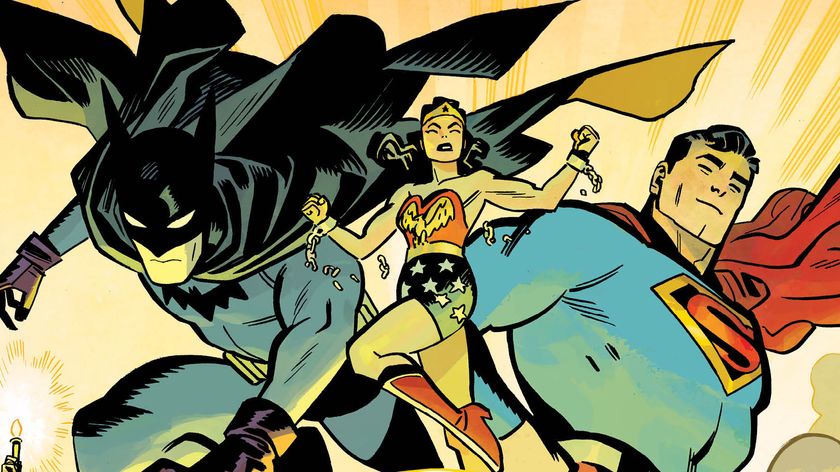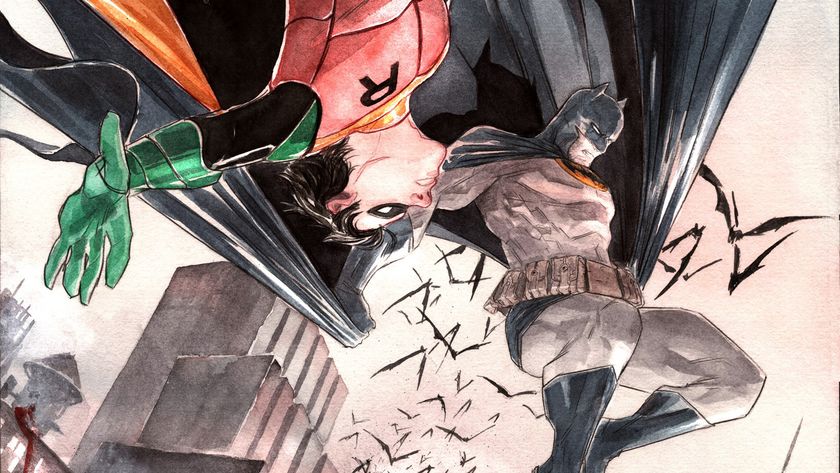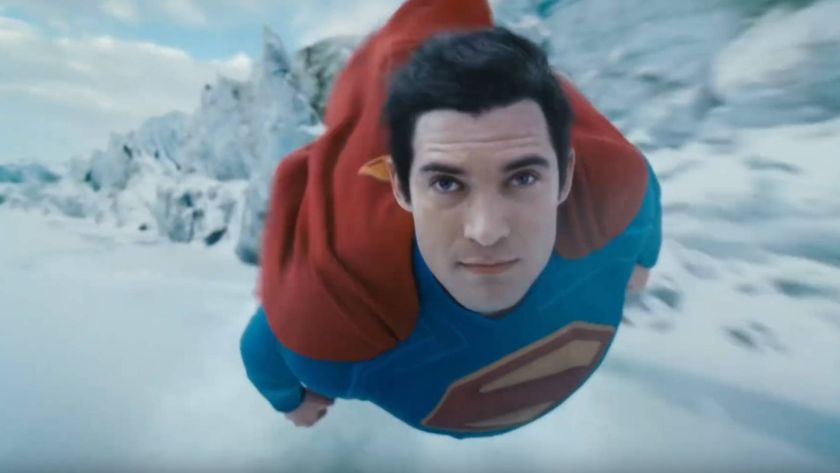Meet the Three Jokers: The Criminal, The Clownish, The Comedian
Batman: Three Jokers artist Jason Fabok shines a spotlight on his and Geoff Johns' upcoming prestige series from DC/Black Label
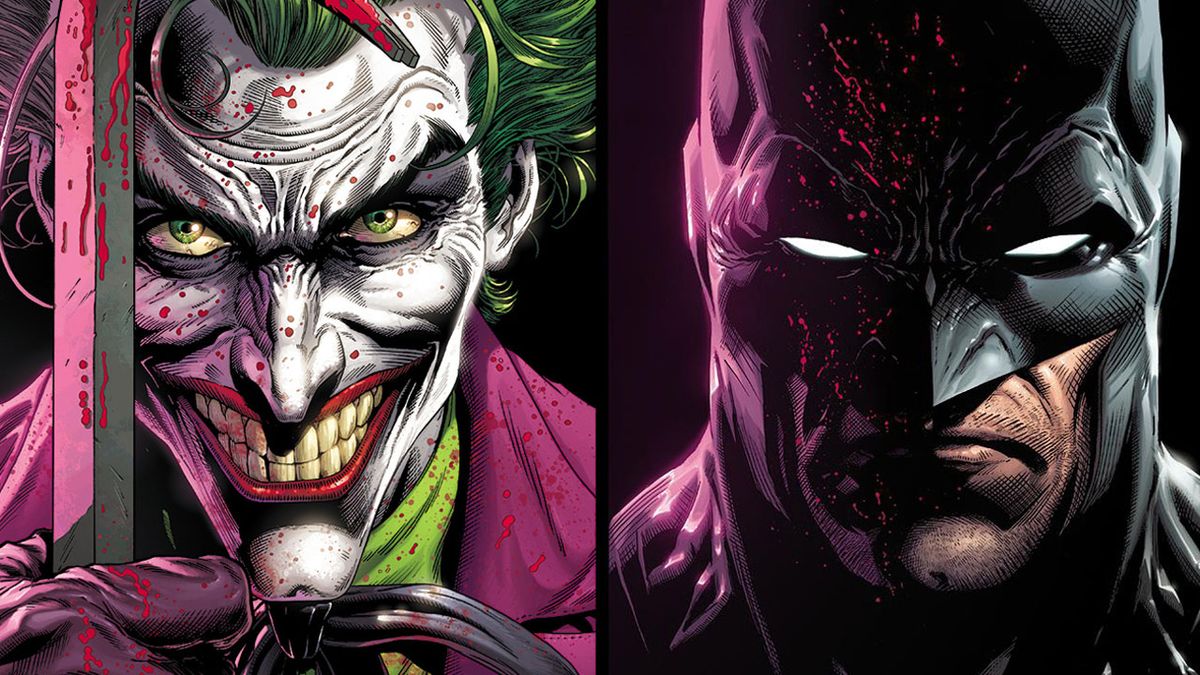
Nearly five years to the day, DC's mystery of the multiple Jokers will be exposed with August 25 debut of Batman: Three Jokers.
Picking up the story from their Justice League arc 'Darkseid War,' writer Geoff Johns and artist Jason Fabok are back to tell what DC has framed as "the ultimate story of Batman and the Joker."
The idea of multiple Jokers was first ignited when, in 'Darkseid War,' Batman took control of the omniscient Mobius Chair and asked a seemingly simple question: "What's The Joker's true name?" It's revealed that this question is quite difficult to answer, instead reveal there's not one Joker... but three.

"30 years after Batman: The Killing Joke changed comics forever, Three Jokers reexamines the myth of who, or what, the Joker is and what is at the heart of his eternal battle with Batman," reads DC's synopsis of Batman: Three Jokers #1. "Find out why there are three Jokers, and what that means for the Dark Knight and the Clown Prince of Crime. It's a mystery unlike any Batman has ever faced!"
Before the three-issue Batman: Three Jokers story hits stands, Newsarama spoke with Fabok about this examination of the Joker, the other Bat-characters he's found a new appreciation for, and most of all what he and Geoff call the Three Jokers.
Newsarama: Jason, you drew the moment where the idea of multiple Jokers came up, back in your Justice League run with Geoff. How much did you know then, and how did you come to know there would be a Three Jokers book Geoff wanted to do?
Jason Fabok: That was something that we actually discussed pretty close to that point. Actually, back even further when Batman first got on the chair, I believe in Justice League #43. Geoff had already told me this idea, and at that time - the next arc or so after we did 'Darkseid War' was actually going to be something with the Three Jokers' characters and that storyline. Then we kind of went separate ways.
Comic deals, prizes and latest news
Get the best comic news, insights, opinions, analysis and more!
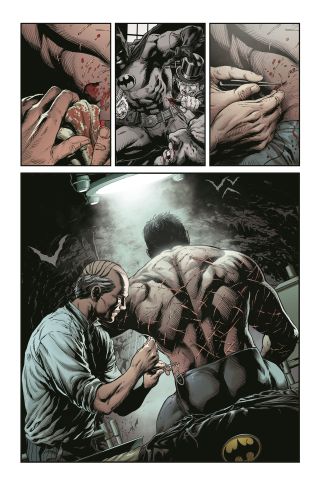
Then a few years ago we decided to start discussing this, but we kind of changed our idea and our plan - we really wanted to focus it more as just a strict Batman story and not a Justice League story.
We've had this idea rolling around in our heads for a while. We really wanted to tell this story and we felt that we had something that was unique and different and yet felt classic. We felt like it would really speak to comic book fans, old and new, and it was something that would really just resonate with the fandom. So, that's when we decided to really dig into it and get serious about it.
Nrama: What was it like working with Geoff again for such a big project?
Fabok: Working with Geoff is always great. He's a very busy guy. He's juggling so many different jobs, especially working in TV and media and all that stuff. Sometimes it's a little slower than you might like, but the one thing - well, there are many things I love about working with Geoff, but one of the big things I love about working with him is the fact that he's a real collaborator.
He's very humble when it comes to the idea and the story that he wants to tell because he wants to include you in on everything. He wants to hear your ideas. He wants to hear if you think something is good, if you think something is bad, if you are feeling a certain way about the direction of the story. He really wants it to be a collaborative effort.
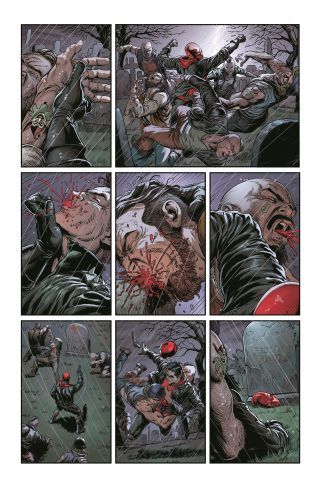
And I think that's something that's missing in a lot of comic book creation. It becomes simply the writer writes the story, hands it to you, and then that's all. And as an artist, I don't believe that's the best way of running a comic book or even running this industry. I think it needs to be more collaborative.
Artists and writers need to come together and really hammer out the story. Only as an artist, it makes you invest that much more in the story that you're telling.
There are many ideas that I threw out to Geoff that made it into this book, and there are many times when he specifically asks me to just have fun and play around with different things, either visually or whatever. Like he's okay with me stretching my wings as well. And at the same time, he's one of the best comic book writers of the last 20 years, and so I also trust him and I trust his gut instincts on story. It just makes for a very pleasant all-around experience.
And I have to say, like this book has taken us a while to do - some of that's because of Geoff's busy schedule. Some of it's because I decided that I wanted to work a little slower. And I have to say, this has been one of the most stress-free two years of my life. I just really enjoyed and loved every minute that I've worked on this book. I've gotten an opportunity to really pour everything into it. Geoff makes it very easy by just giving you really great stories that you had a hand in creating. Again, like I said, I think it makes for a better comic book in the end.
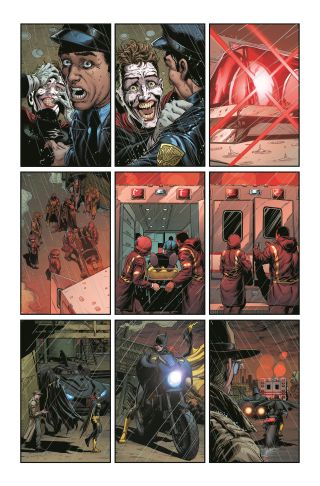
Nrama: Piggybacking off of that, after coming off monthly comic books, what was it like drawing Three Jokers with a looser deadline since DC is choosing not to solicit Black Label books until they're complete?
Fabok: There's a pro and a con to it.
The pro is that you can take your time with it. When you're on a monthly book, if something comes up on the weekend - you're working through the weekend. You make many sacrifices. You can't just get up and go hang out with your family or go to a family event.
Like there were so many times over the last seven or eight years in my career where I had to say no to a lot of things because the deadline was there. I knew if I didn't work through that day or that weekend or whatever, I was never going to get this work done. And I really pride myself on the fact that I don't want fill-ins and I don't want other people coming in and working on the same thing I'm doing. I want consistency out of myself and out of the work because I care about it.
So being able to say, 'I'm going to take this weekend off and we're going to go and do this and do that.' It's only brought me closer with my family. It's been a real blessing. And I would suggest that more artists do this, especially the big ones who don't need to be cramming on monthlies. Yanick Paquette actually gave me this advice a few years back, and it's been the best advice I've ever taken.
The flip side of that though, is that not having a deadline means that you spend a lot more time perfecting the work instead of going with your gut feeling. That's tough because - I've gone back on a lot of these pages and I've tweaked things and I changed things and I'm grateful to have that opportunity because it only makes the artwork and the book that much better, but at the same time, it's because there's no deadline. You keep fiddling with it and fiddling with it.
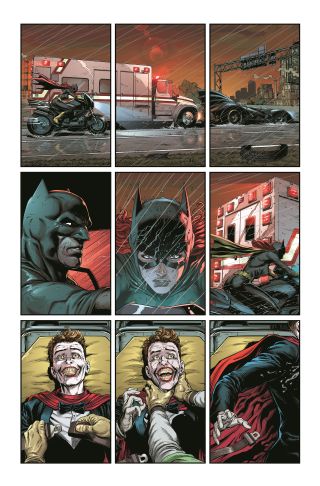
So, having a deadline is a good thing, and I think it does focus you on the task at hand. But not having a deadline at the same time is also very freeing. And I kind of imposed my own deadlines on myself. I made sure that I had a certain amount of pages done every week and I wanted to have this book done by this date, and we were able to land on those for the most part.
It's a different experience. I think for future projects, I'll want more of an imposed deadline, but maybe just with a little bit more leeway, instead of locking out a book in a month, give me a month and a half or two months or something like that. So yeah, there's always a pro and a con for everything in life - that's part of this one.
Nrama: The Joker has not only caused a lot of trauma for Batman, but Barbara Gordon and Jason Todd as well. How did you want to dig into these wounds with your art?
Fabok: The fun thing about this book was that I was able to draw a group of characters that I've never drawn before. I've drawn a lot of Batman stuff, but I never touched on the Joker much except for maybe a cover. I've never drawn Red Hood or Batgirl other than a few tiny panels here and there over the last few years. So, I really had a chance to get into these characters' heads.
Geoff and I discussed a lot about who these characters were and what our vision for them was in our story, and that really helped me to get into them and really just understand them. One of your jobs as an artist, essentially, you're the film director; like you're directing the shot, and you're directing the action and the emotion on the page, but you're also an actor in a way too.

So, a lot of the times you have to really read through the dialogue and you almost act it out yourself. When I was in school for animation that's what our teachers always told us: 'Try to act out the scene that you're trying to animate so that you can better understand how a person would move, talk, think, or the subtle little movements that they would do.'
I do that a lot just with myself, I'll talk myself through the scene. So, I was really able to get into these characters and try to unlock some of the emotion behind what they're saying and what they're trying to portray. We feel that we've created some really compelling artwork and stories with these characters.
I've come to really love Jason Todd and Barbara Gordon. I always liked Batgirl going all the way back to the animated series and even the old Batman '66 show. I've always been a fan of Batgirl, but Jason Todd I didn't really know much about. And I didn't really see the appeal for the character, admittedly, prior to this, but as I've worked through this book, I've really gotten into these characters, into their lives, into their story, and into the emotion that they're going through. I've really come to love them.
Jason Todd, especially to me becomes a real standout. I really feel like Geoff's written something that's going to really resonate with fans. We take them through a very unique journey. And I'm excited to see fans' reactions to all of it really.
Nrama: There have been plenty of Joker vs. Batman stories - how did you want to make this one stand apart from the rest?

Fabok: We really looked at some of the great things that people really love about the Joker from classic stories. The stories that really resonated with fans, especially ones like Batman: The Killing Joke and 'A Death in the Family.' These are stories that Batman fans and just comic book fans, in general, are still buying, collecting, and reading. Those books were both released in my day, the late '80s. They've been reading these stories for years.
We really looked at what made these books so special. And I think a lot of it had to do with emotional stories that the reader really connected with, some shock and awe, and also just artwork that really speaks to people, speaks to the comic book audience.
I know from my part I really took a lot of inspiration from Brian Bolland. I have three different versions of Killing Joke sitting next to my desk, and I used those books every day; just looking at it, and seeing how he composed the shots. Not trying to essentially copy what he was doing, but bring a lot of that influence into the way I was drawing the book and the way I was doing panel layouts.
I really set out with the goal of making this book feel like it could exist at multiple different eras. I wanted it to feel classic in some ways. I really wanted this book to be one that people in 20 years could pick up and just jump right into it and feel like it's just part of the modern comic book reading experience.
That's kind of how I feel like Killing Joke is - you can pick that book up and you can read it now, and the artwork is just still so stellar and unbelievably perfect that as an artist it just melts my brain to think that anybody can draw as well as Brian Bolland. Like I've tried. I just don't have his skill, like it's just unbelievable artwork.
I really poured a lot of effort into these pages to try and make them me, but also try to make them feel classic. When I was younger in my career and really collecting comics as a teenager, I was into the big and bold kind of styles of Jim Lee, Marc Silvestri, David Finch - the stuff that really just grabs you.
Now that I'm in my 30s – I find myself looking more at classic comics and trying to bring some of that into my work because I really feel like it just adds a dimension to your work that makes your work live longer if it has a classic feel to it. So, I'm looking at a lot of like Dave Gibbons from Watchmen and Brian Bolland - these kinds of guys. I just really feel like it brings a different dynamic to my work and it felt right for this project, maybe for the next project, I'll do something totally different artistically. I'll be more rough, loose, and scratchy. I don't know. It just depends on what the project is, but with this one I wanted it to feel classic.
Nrama: How did you make the three Jokers different and defined from one another as they appear in the same book?
Fabok: Part of us wanted to make something different and defined, and part of it is that they're also supposed to look a little similar to each other. Visually, Batman would see that if there were these three jokers - a lot of people complained, 'Well how could the greatest detective not know this?' Well, because they all look very much the same. There are little visual differences to them that you'll see in the book.
The biggest one that we did was with the Golden Age Joker, we called him 'the Criminal Joker.' And he's the one that doesn't really smile. And that kind of goes back to Batman #1 in 1940, where there are these creepy panels where he's not smiling and then there are creepy panels with big grins and whatnot. We chose to really lock in on the not smiling part, and it's so much creepier. It's a cold calculating version of the Joker and he's a criminal mastermind. It's just a very different feeling to the Joker.
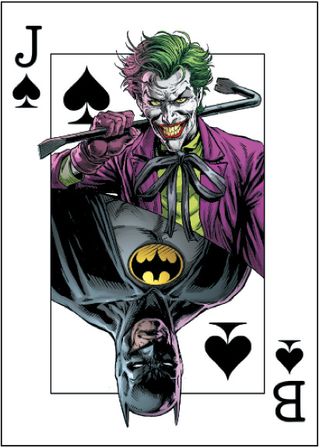
Then we have 'the Clownish Joker' as we call him. He's like the classic Joker from the '40s and '50s, and so everything with him is brighter, louder, and a lot cornier - like the big gags that would happen in the '50s comic books, those kinds of things that were a lot of fun. We touch on a lot of those and tip our hat to some of those moments from the classic comic books in the '50s and '60s, especially.
Then you have your modern age Joker, who we call 'the Comedian Joker.' He's The Killing Joke joker. He's very psychotic and just evil. He's always smiling and cackling. I played up a lot on that with the way that Brian Bolland drew him in those classic books.
I don't want to go into too much more because I want people to just read it and see how it all comes together, but each one is its own thing. Yet, each one also feels like they're part of the other versions of the Joker. That's what makes the mystery a little bit more fun.
Nrama: How will Batman: Three Jokers affect the larger DC Universe?
Fabok: I don't want to over-hype things, but we have an incredible ending to this story that if DC wishes - it will have a huge impact on things. We set out with the story to tell it within continuity, but also kind of exists in its own thing.
With 'Darkseid War,' it was the same thing: there were all these things that were going on in the DC universe - like Batman was now Jim Gordon, Superman had no powers, Green Lantern had some sort of power batteries thing that was.
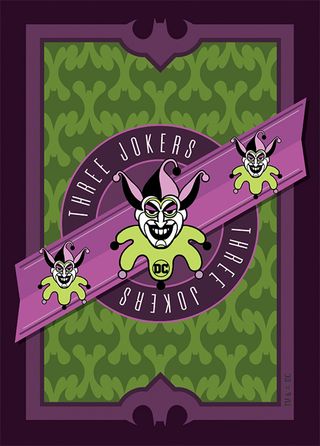
I don't even remember all the different ins and outs, but we decided when we were doing 'Darkseid War' that instead of integrating everything that was happening in the larger DC universe at that time, we decided to focus our characters more on the classic versions because we felt that by doing that it wouldn't be locked to that specific time period in DC's continuity or history.
It would be open for people for a longer period of time. So, if you read it now, you just automatically understand who these characters are and their costumes because we chose to do the classic versions of the costumes and all this sort of thing.
Same thing with this; there are all kinds of stuff that's happened in the DC universe to Batman, to his allies, to his friends. But we decided to set our book, it's in the modern era, but we kind of just set it and forgot about everything else that was going on. We said 'Let's tell the best story from page one to page 144, let's make this thing a self-contained story that anybody can pick up at any time.' And you don't need to really know anything except for the few things that we explained to you in the opening pages of the book and off you go.
I think by doing that, it opens up your book to so many more people and it has a chance of standing the test of time far longer than a lot of other books that are on the shelf.
That's just something that we decided that we wanted to do. If this book is well received and people really like it then there are stories that can be told that flow out of this. We'll have to see, but really we just tried to make this the best 144 pages of comic books that we possibly could within the time that we had. And just to tell a really fun, engaging, and emotional story. I hope that it hits the audience that we want it to hit.
Kat has been working in the comic book industry as a critic for over a decade with her YouTube channel, Comic Uno. She’s been writing for Newsarama since 2017 and also currently writes for DC Comics’ DC Universe - bylines include IGN, Fandom, and TV Guide. She writes her own comics with her titles Like Father, Like Daughter and They Call Her…The Dancer. Calamia has a Bachelor’s degree in Communications and minor in Journalism through Marymount Manhattan and a MFA in Writing and Producing Television from LIU Brooklyn.

